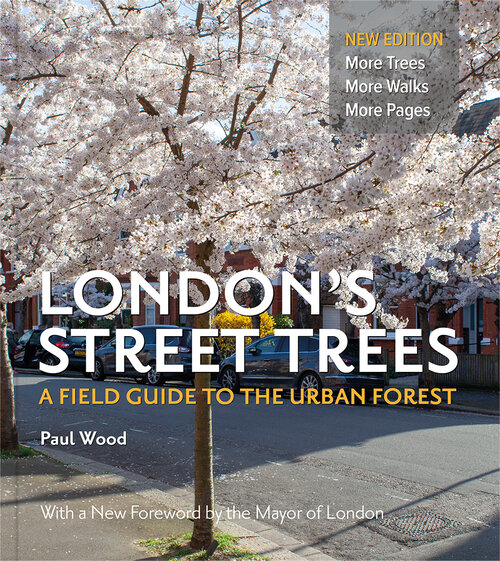Paul Wood’s London’s Street Trees: A Field Guide to the Urban Forest has just been published in an updated edition by Safe Haven. Clare Wadd gives it a once-over.

A new edition of London’s Street Trees: A Field Guide to the Urban Forest, with “more trees, more walks and more pages” has just been published and will help make the daily lockdown walks of Londoners across the city hugely more interesting and satisfying.
Before the first edition was published in 2017, it had never really occurred to me to think about the enormous variety of trees on our London streets, let alone how they got there. I’ve always walked around the city for transport and pleasure, but took the street trees for granted until the first edition of London’s Street Trees made me stop, think, enjoy and then start to make pathetic attempts to identify (sometimes including tweeting pictures at the author). More recently, events in Sheffield have made many of us alive to how much trees set the tone of a neighbourhood and how undervalued and poorly treated they can be.
Thanks to London’s Street Trees, I now know that a huge diversity of over 400 types of tree makes up our urban forest. Street trees were first planted in London only 150 years ago, and 100 years ago sixty percent were estimated to be London planes, compared with only around 3% now. It’s impossible today to imagine London, or indeed other cities, without them lining our streets, brightening (metaphorically) and shading (more literally) our walks and runs and cycles and bus rides. They’re also quietly busy removing pollution, storing CO2, providing ecosystems for birds, nectar for pollinators, nocturnal foraging routes for bats and a home for lichens, fungi and mistletoe. Except the London plane of course, which is a bit useless for biodiversity and isn’t even native to London.
London’s Street Trees is a spotter’s guide, but with a huge amount of fascinating background information about how and why the many different street trees came to be in the different places they’ve been planted, how and where they might have been grown, who looks after them and what they might worth as community assets, based on girth, up to hundreds of thousands of pounds.
Whilst most tree guides are about native species, this book celebrates London’s place as a melting pot of trees (as well as people), planting decisions good and bad, the weird and the wonderful. Different boroughs had and have different policies and hence different trees – with some determined by individual tree officers or councillors with specific tastes. Winterbrook Road in Herne Hill is planted exclusively with Japanese Yoshino cherries because a former councillor was inspired by the planting in Washington DC where she grew up, and Ada Salter is responsible for the preponderance of Tree of Heaven in Bermondsey, where she was mayor in the 1920s. London also boasts rare remaining elms in Archway, Wembley and Marylebone, there’s a Lewisham black mulberry, giant redwoods in Edgware, plus trees from New Zealand in Vauxhall, and from Australia in Pimlico.
The perfectly named author, Paul Wood, conveys an enormous amount of information with a light touch and some gentle humour – as he does in his highly recommended tree walks and talks. The book’s format is a double-spread per tree with pictures of several examples to illustrate, with the new edition a couple of inches bigger than the first and benefiting from three more years spent photographing the colourful splendour of the urban forest. Whether you’re in the centre or the suburbs, and whichever suburb you’re in, London’s Street Trees will teach you something interesting about a tree on a street you know which, if you’re like me, you may have never even have noticed before.
*
The updated edition of London’s Street Trees is out now and available here, priced £14.99.